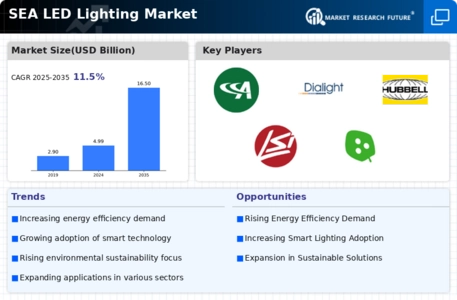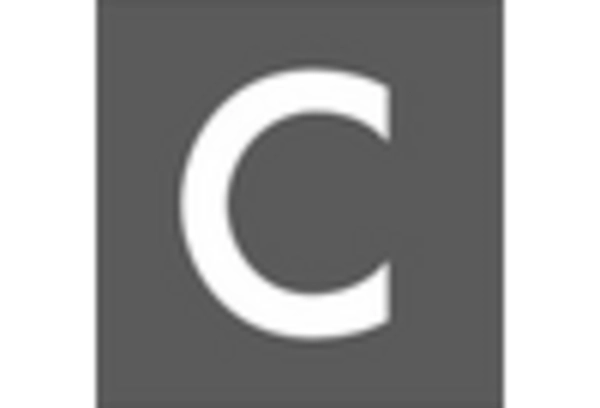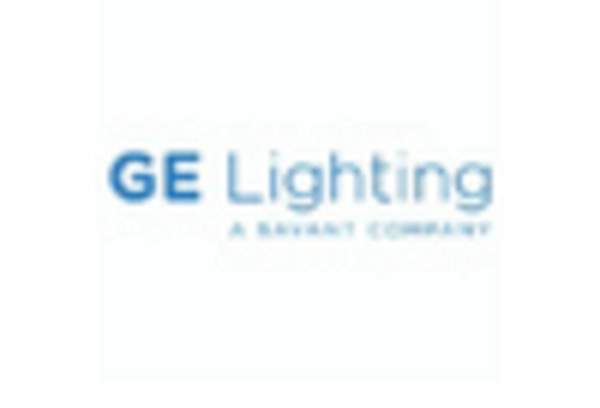Government Incentives and Policies
Government incentives and policies play a crucial role in shaping the SEA LED Lighting Market. Many Southeast Asian governments are implementing programs to promote energy efficiency and reduce greenhouse gas emissions. These initiatives often include financial incentives for businesses and consumers to adopt LED lighting solutions. For instance, subsidies and tax rebates for energy-efficient products are becoming more common, making LED lighting more accessible to a broader audience. As of 2025, it is anticipated that these policies will lead to a significant increase in LED adoption across various sectors, including residential, commercial, and industrial. The proactive stance of governments in promoting sustainable lighting solutions is likely to create a favorable environment for the SEA LED Lighting Market, fostering innovation and investment in this sector.
Growth of E-commerce and Online Retail
The rise of e-commerce and online retail is transforming the way consumers purchase lighting solutions, significantly impacting the SEA LED Lighting Market. As more consumers turn to online platforms for their shopping needs, the accessibility of LED lighting products has increased. This trend is particularly pronounced in Southeast Asia, where internet penetration is on the rise, and online shopping is becoming a preferred method for many. By 2025, it is projected that online sales of LED lighting products could account for a substantial portion of the market, driven by convenience and competitive pricing. Additionally, e-commerce platforms often provide consumers with a wider range of options and detailed product information, facilitating informed purchasing decisions. This shift towards online retail is likely to enhance the visibility and reach of the SEA LED Lighting Market, enabling manufacturers and retailers to tap into new customer segments.
Rising Awareness of Environmental Impact
There is a growing awareness among consumers and businesses regarding the environmental impact of lighting solutions, which is influencing the SEA LED Lighting Market. As sustainability becomes a priority, many organizations are shifting towards eco-friendly lighting options. LED lights, which consume significantly less energy and have a lower carbon footprint compared to traditional lighting, are increasingly favored. In 2025, it is estimated that the adoption of LED lighting could reduce energy consumption in the region by up to 30%, contributing to national and global sustainability goals. This shift is not only driven by consumer preferences but also by regulatory frameworks encouraging energy-efficient practices. Consequently, the SEA LED Lighting Market is likely to benefit from this heightened focus on environmental responsibility, as more stakeholders seek to align their operations with sustainable practices.
Technological Advancements in LED Lighting
The SEA LED Lighting Market is experiencing a surge in technological advancements that enhance the performance and efficiency of LED lighting solutions. Innovations such as improved semiconductor materials and advanced optics are leading to higher luminous efficacy and longer lifespans for LED products. As of 2025, the market is projected to grow at a compound annual growth rate of approximately 15%, driven by these advancements. Furthermore, the integration of smart technologies, such as IoT and wireless controls, is transforming traditional lighting systems into intelligent solutions. This evolution not only improves energy management but also offers enhanced user experiences, thereby attracting both residential and commercial consumers. The ongoing research and development in this sector suggest that the SEA LED Lighting Market will continue to evolve, potentially leading to even more groundbreaking innovations in the near future.
Increasing Urbanization and Infrastructure Development
Urbanization in Southeast Asia is accelerating, with cities expanding rapidly to accommodate growing populations. This trend is significantly impacting the SEA LED Lighting Market, as urban areas require efficient and sustainable lighting solutions to support infrastructure development. As of 2025, urban centers are projected to account for over 70% of the region's energy consumption, necessitating the adoption of energy-efficient lighting technologies. LED lighting, known for its low energy consumption and long lifespan, is becoming the preferred choice for urban planners and developers. Moreover, government initiatives aimed at modernizing urban infrastructure are likely to further drive the demand for LED lighting solutions. The SEA LED Lighting Market appears poised for growth as cities invest in smart lighting systems that enhance safety, reduce energy costs, and improve the overall quality of urban life.

















Leave a Comment